Surf 8', a new Selway Fisher sail-and-oar mini-cruiser
12
12

|
mike160304 |
Surf 8', a new Selway Fisher sail-and-oar mini-cruiser
|
|
Build photos 1&2.
The marine plywood is 3-ply Okoume. The 7 planks are 5.0 mm thick, the 2 transoms 5.6 mm. Total plywood weight is 22.3 lb. I like the fore transom shape, it reminds me of a 12th-century cog. . . .  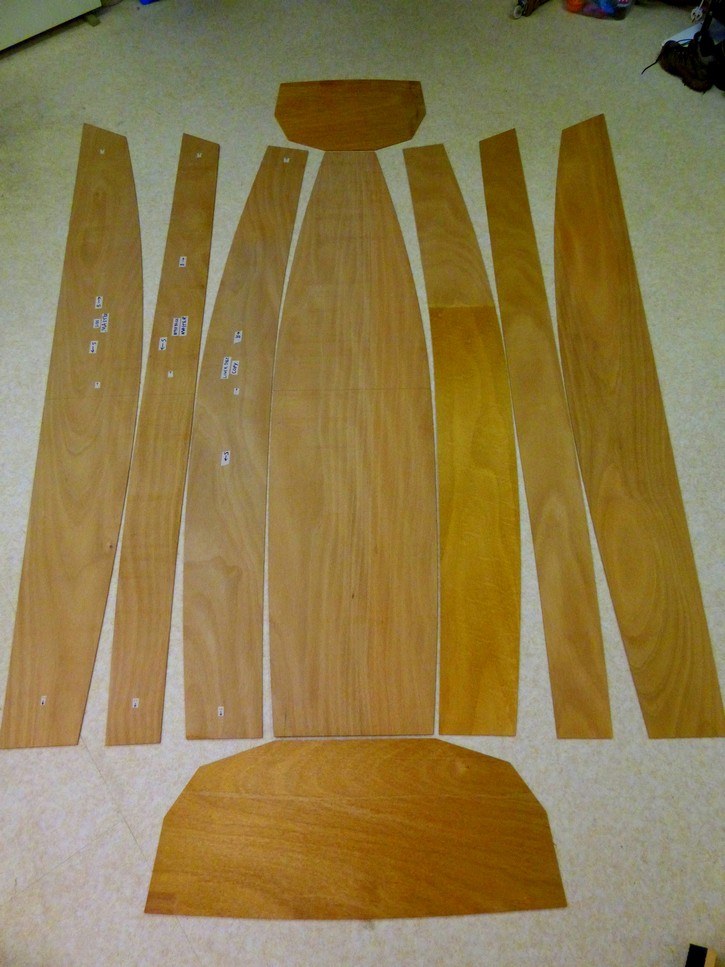 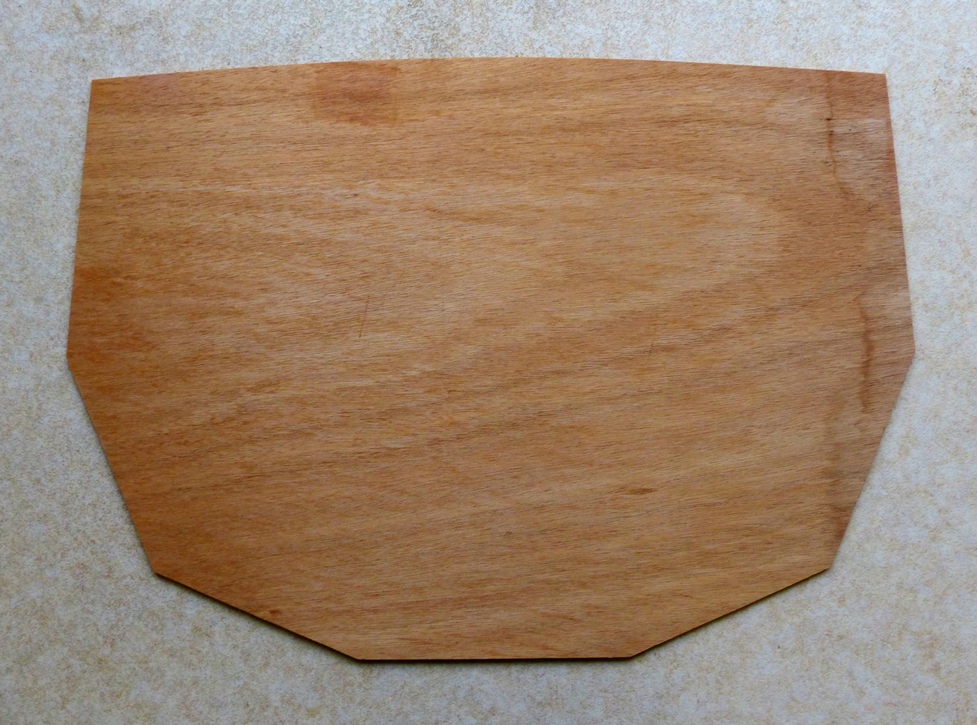 Regards, Mike |

|
mike160304 |
Re: Surf 8', a new Selway Fisher sail-and-oar mini-cruiser
|
|
HOW TO SAW WOOD FOR LAMINATED MAIN FRAME?
Making a lightweight laminated boat frame has been on my Bucket List for years, the way some people have Macchu Picchu and The Great Wall of China. So I would like to make one for Surf, instead of the plywood frame in the Plans. Partly because this will make the midships more spacious, partly because I want to make a laminated frame, and partly because I am not very good at doing what I am told . . . 
I have studied at length how to make up the curved frame, using Epoxy or Polyurethane glue, so I need no advice there. Also I shall use my old B&D drill attachment circular saw with its rip saw blade, having a thinner kerf than my bigger circular saw, and wasting less spruce. My only question is, how best to slice my 1" x 1" spruce lengthwise into 1" x 4 mm slices for laminating into the curve? The growth rings go roughly straight across the spruce, not corner to corner. So do I saw at 90 degrees to the growth rings (= rift sawn), or in line with the growth rings (= plain sawn or slash sawn)? And do I "alternately turn them round" or "alternately turn them end to end", or both, when I assemble them for laminating? I guess it is a bit like laminating a longbow - the growth ring direction may make a big difference to how stiff and powerful the longbow is, and how long it retains its stiffness and hence performance. Regards, Mike |

|
Paul H (admin) |
Re: Surf 8', a new Selway Fisher sail-and-oar mini-cruiser
|
|
Mike,
I'm not an expert, but I know that some people have made a mast by ripping the wood in half down the middle, reversing one side and gluing both together. That usually balances out the twist/bend forces so the final spar stays more "straight-ish" than the original. Repeat that for each pair?? My guess is that cutting across the growth increases the chance of splitting, but its only a guess based on experience. It's cheap enough to try both approaches and see which works best on a 2ft test curve. Good luck and post some pics, including when it went wrong  cheers Paul |

|
mike160304 |
Re: Surf 8', a new Selway Fisher sail-and-oar mini-cruiser
|
|
Masts and oars, as you say, are often made by sawing the wood lengthwise down the middle and
a) rotating one half 180 degrees or b) rotating one half 180 degrees and also turning it over end for end. One gives you "points diametrically opposed", the other gives you, "mirror image", and there are arguments about which balances out the forces better. I am not about to make a mast, spars or oars like that as I shall be using bamboo. For a laminated frame, it's going to be a different scene with, say, ten 4 mm x 1" slices making up a 40 mm thick lamination, as I can choose up front "rift sawn" or "plain sawn/slash sawn". No doubt I could work it out for myself with various tests, like anything else, but I thought that someone might have a ready-made recommendation based on their own studies. Regards, Mike |

|
Port-Na-Storm |
Re: Surf 8', a new Selway Fisher sail-and-oar mini-cruiser
|
|
Hi Mike,
If you are going for 10 laminations I don't think it will make any difference to the strength of the frame which way it is cut. What it will make a difference to is how well the laminations bend without splintering, which of course depends on the shape of the frame. I presume the build is going to be stitch and glue? Do you plan to joggle the frame into the planks? The reason I ask is I'd normally expect to use the plywood frame as a former when stitching the whole wriggly mess together. You've mentioned elsewhere that you don't plan to sheath the boat, wise, what do you plan to do about the external seams? Tape? Have you thought about laminating plywood? It works really well and looks great. 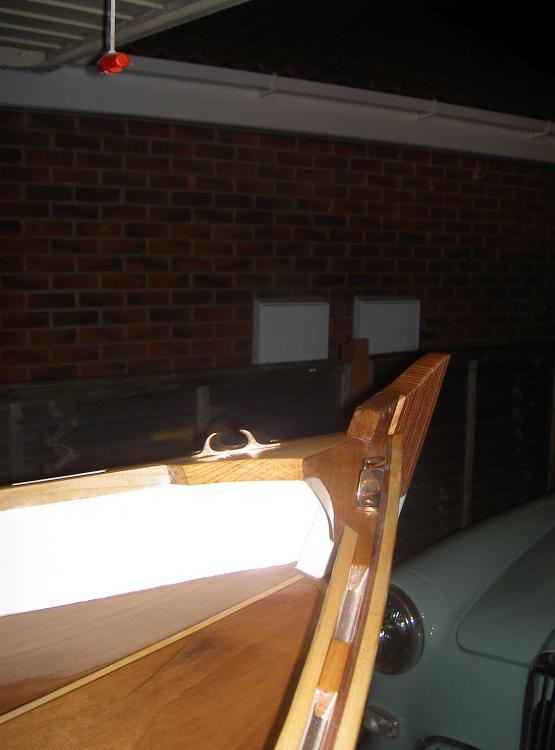
|

|
alopenboat |
Re: Surf 8', a new Selway Fisher sail-and-oar mini-cruiser
|
|
On 6 Jan 2015 at 11:30, Port-Na-Storm [via UK HBBR Forum] wrote:
> > Have you thought about laminating plywood? It works really well and > looks great. One problem with laminated ply is that you are relying on the manufacturer's glue. A friend, instead of laminating his hatch beams from solid wood (as the plans stated), used a few layers of ply. The beam failed when the ply lamentations separated. -- Sail when you can, row when you must, motor when you have to be at work in the morning. Alastair Law Yeovil, England. <http://www.little.jim.freeuk.com> |

|
Port-Na-Storm |
Re: Surf 8', a new Selway Fisher sail-and-oar mini-cruiser
|
|
Now hang on a minute there Alistair.
Last time I looked most of the boats in these parts were built from Plywood. Now it is true that many of them are sheathed in finest glass, some are sheathed in even finer TESCO polycotton all soaked in sticky and expensive gloop, sum indeed are taped, but least said etc.  But the finest and fairest of them all are clinker ply, or indeed lapstrake as our cousins like to call it. Here's one I made earlier. 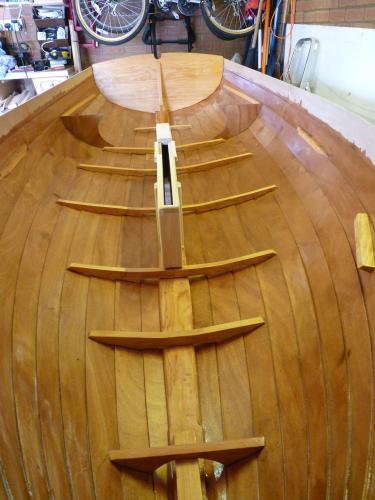 The upper edge of each plank is bevelled so that it sits flush against the next plank. The epoxy in the join can only soak through the first ply when it will be stopped by the glue. So in effect every land is relying on the join between the first layer of glue in the plywood and the second lamination. Am I making sense here? Pay attention at the back! Should I be worried my boat is going to fall apart? Do I look Worried? 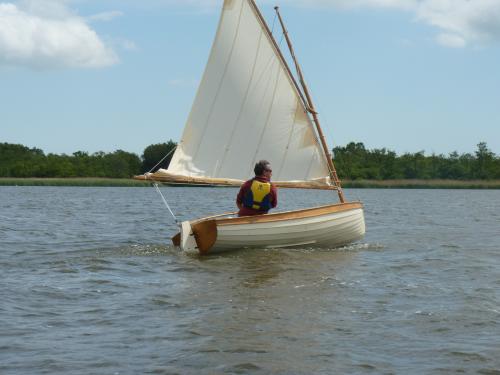 OK I must admit confessing to CW about being slightly concerned about the integrity of my boat the last time we went bouncing out across Chichester Harbour into the teeth of a stiff breeze. I wonder where your friend got his plywood? Anyhoo, I am creating a diversion on Mike's thread, and I'm sure people are queueing up to give him sensible advice. |

|
Paul H (admin) |
Re: Surf 8', a new Selway Fisher sail-and-oar mini-cruiser
|
|
And MilliBee is built of dubious ply with epoxy fillets taped and the entire hull wrapped in thick glass fibre and almost 5 litres of epoxy.
She has scraped along rusty bolts in the Broads without blinking. Would I trust her for a trip around the IoW? Yes as long as CW is there to tell me if we have to turn right or left. I get so confused these days, it must be the drugs. Paul |

|
mike160304 |
Re: Surf 8', a new Selway Fisher sail-and-oar mini-cruiser
|
|
This post was updated on .
In reply to this post by Port-Na-Storm
If you are going for 10 laminations I don't think it will make any difference to the strength of the frame which way it is cut.
I don't know, but as a test, I might just cut 2 short pieces, one rift and one slash, plane to exact same thickness ca 4 mm, and use weights or a spring balance to see whether one is stiffer than the other. If one is stiffer than the other, obviously a 10-piece lamination will be stiffer than the other, for the same weight or thickness. What it will make a difference to is how well the laminations bend without splintering, which of course depends on the shape of the frame. Yes, we are sometimes told to dry-trial the bending first, but I am not sure that it is a good idea, because the veneers bend easier when coated with wet Epoxy or Polyurethane glue. I presume the build is going to be stitch and glue? Do you plan to joggle the frame into the planks? The reason I ask is I'd normally expect to use the plywood frame as a former when stitching the whole wriggly mess together. I don't know yet, but the frame is most likely to have a natural curve on the outside, with more or less Epoxy infill where it touches (or almost touches) each plank. The Epoxy might either leave gaps at the taped corners or fill them in completely. The frame would be made completely on an 18 mm plywood board that I have already marked out. I have also already made a temporary hardboard-and-batten frame to be stitched 110 mm behind the proper frame (dimensions from Selway Fisher) in case I need that first, but I may or may not use it now, I don't know. Originally I was going to make the permanent frame in-situ, but I went off that idea. You've mentioned elsewhere that you don't plan to sheath the boat, wise, what do you plan to do about the external seams? Tape? There will be 40 mm tape on each seam, inside and outside. On the inside, Epoxy filleting under the tape may be minimal or zero. On the outside, the little "V" seam gaps will first get plenty of unfilled Epoxy soaked into them before I syringe in the filled Epoxy, then the tape goes on top. Have you thought about laminating plywood? It works really well and looks great. Yes, I have, but its stiffness per weight/thickness would be lower, I think. Thanks, regards, Mike |

|
mike160304 |
Re: Surf 8', a new Selway Fisher sail-and-oar mini-cruiser
|
|
In reply to this post by Port-Na-Storm
Port-Na-Storm: The upper edge of each plank is bevelled so that it sits flush against the next plank. The epoxy in the join can only soak through the first ply when it will be stopped by the glue. So in effect every land is relying on the join between the first layer of glue in the plywood and the second lamination. Am I making sense here? Pay attention at the back!
Should I be worried my boat is going to fall apart? Do I look Worried? My Aerolite-glued National 12 clinker hull, with no Epoxy sheathing, and with mere oil-based varnish on top, did not fall apart. My Mirror Dinghy, with rubbishy 4.5 mm plywood, suspect Polyester resin, no Epoxy sheathing but with 2-pack polyurethane paint/varnish, did not fall apart. All this was before Epoxy vendors told us how wonderful Epoxy sheathing is, especially for their profits. Sheathing may be fine if you are leaving a boat in the water more, or if high-stress racing tires out bare plywood more, but it is a good idea to check the cost and weight penalty before you decide to do it. My Surf 8' with ca 50 lb hull, everything lightweight, and with the unstayed bamboo rig eliminating weight and compression forces, is unlikely to be a high stress zone. As for leaving her in the water, she will spend over 99% of her life tucked up indoors and UV-free, so A2 stainless steel "bits" and MAS Epoxy with no paint or varnish on top are unlikely to be highly stressed either. Regards, Mike |

|
mike160304 |
Re: Surf 8', a new Selway Fisher sail-and-oar mini-cruiser
|
|
In reply to this post by alopenboat
Alastair, I think I asked you how you fitted plastic curtain track to the keel/bilge runners of your dinghy? PLease?
Mike |

|
alopenboat |
Re: Surf 8', a new Selway Fisher sail-and-oar mini-cruiser
|
|
In reply to this post by Port-Na-Storm
On 6 Jan 2015 at 13:36, Port-Na-Storm [via UK HBBR Forum] wrote:
> Now hang on a minute there Alistair. > Last time I looked most of the boats in these parts were built from > Plywood. And most of them will have been properly designed to take into account the relevant loads. The example I cited was a deck beam about an inch wide by an inch deep, supposedly made from 3 laminates of Douglas Fir. His was made, I think, from 4 layers of 6mm 3 ply. The epoxy joints were sound but the manufacturers glue had failed in a couple of places. I don't know what sort of ply it was, but it was presumably offcuts from the build and, knowing the builder, I would be surprised if it wasn't at least labelled as "marine ply". -- Sail when you can, row when you must, motor when you have to be at work in the morning. Alastair Law Yeovil, England. <http://www.little.jim.freeuk.com> |

|
mike160304 |
Re: Surf 8', a new Selway Fisher sail-and-oar mini-cruiser
|
|
In reply to this post by mike160304
Re LAMINATING a MAIN FRAME - There are three 5-metre x 22 mm x 22 mm lengths of spruce here, each with the growth rings going almost straight across, not corner to corner. I have tested them for stiffness in the "rift sawn" and "plain sawn" directions by putting the ends on 2 stools, placing weights on the middle and measuring how far they bend. To my surprise, they are no stiffer in the rift sawn orientation than in the plain sawn orientation, So in this respect, it does not matter whether I rift saw or plain saw them to make 4-5 mm laminating veneers, the stiffness of the frame will be the same. However, looking at the ends of these and other lengths of spruce, there is a clear pattern: any splits are at right angles to the growth rings. So in the unlikely event of any splits developing in the laminated frame, rift sawn veneers would tend to split across the frame and plain sawn veneers would tend to split vertical to the frame. The latter would, I think, make less difference to the strength of the frame, therefore I think the veneers should be plain sawn. 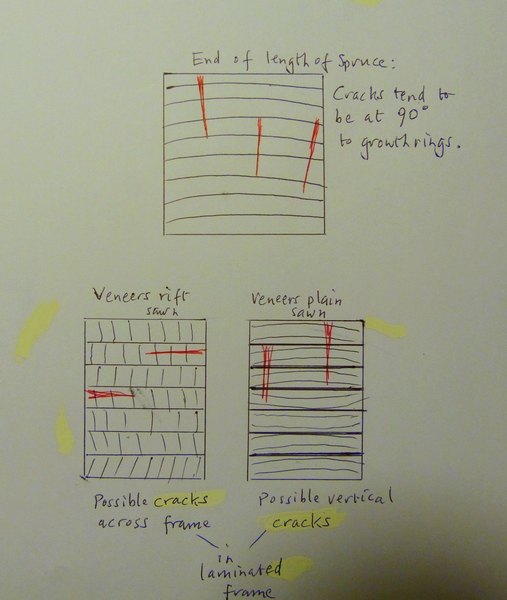 Regards, Mike |

|
Paul H (admin) |
Re: Surf 8', a new Selway Fisher sail-and-oar mini-cruiser
|
|
Agreed - the epoxy will prevent splitting of the vertical cracks, assuming you make sure the potential cracks do not "line up".
I have done similar when gluing the "end grain" of ply and spruce. I always try to avoid an exposed end grain or any area that could crack and ensure it has a liberal coating of epoxy. On MilliBee's transom there is a length of oak to strengthen the plywood transom width wise. I deliberately glued the oak 4mm above the ply and filled in the step with thickened epoxy. When cured I sanded it flat and added more epoxy until I had a good edge, then rounded it slightly with a sander and painted the whole lot. The ply grain was held firm by the 4mm epoxy, with no chance of splitting even after bumps and scrapes from outboards. The white Jotun 2 pack protects the epoxy from UV as well as giving it mechanical protection. Still good after almost 10 years. Ditto on the inwhales and outwhales which overlap the 6mm end grain by 2 or 3 mm, which was filled with thickened epoxy before painting. -Paul |

|
mike160304 |
Re: Surf 8', a new Selway Fisher sail-and-oar mini-cruiser
|
|
Your overlap-and-fill technique sounds very thorough, Paul.
For end grains, or holes, I usually make up an unfilled, thin Epoxy mix first, warm the end grain or hole with a hair dryer and work plenty of epoxy into it while re-applying the hair dryer. As it cools, the air in the pores of the end grain contracts and sucks the epoxy into it. Then I add the filler to the Epoxy and carry on filling. Or of course with bigger jobs, the filled Epoxy is a second mix applied soon after the first one. Some beginners have problems because they inadvertently reverse the process, painting the epoxy onto cold wood and then applying warmth to help setting, so that the air in the pores expands outwards through the epoxy. It's an area where amateurs can do a better job than professionals because amateurs don't have to charge a customer for their time. If I start getting tired and impatient, I stop enjoying it and I try to take a break, or start again tomorrow. Mike |
|
|
If I may interject as someone whos work was tested to destruction. When Inwe had her slight problem with the artic in Belgium the one thing that did not fail was the clinker joints, epoxied as per. As long as you use good quality marine ply, not cheap marine ply from certain African countries, and as Graham said plane the joints properly the epoxy mixture can be applied to the joint as you progress. Although Inwe suffered catastrophic failure, so would you with 32 tonnes up your back---e, the joints did not fail. I have always used only one application.
Richard |

|
mike160304 |
Re: Surf 8', a new Selway Fisher sail-and-oar mini-cruiser
|
|
Thanks Richard, that was a good test . . . My obsession with working neat epoxy into a joint, end grain or hole, before applying a filled epoxy mix, has more to do with my perception of how water can get behind epoxy if there is any space for it, and is less about the possible effect of artics, meteorites, hand grenades, etc. I can't help it, it's just the way I am.
Mike |
|
|
If you plan to laminate your sawn pieces and you need a tight curve, make sure the wood is green, if not chuck it into a water bathe for a few days and if you can't steam it bend it, let it dry in clamp, leave for a week then glue it. If the curve is to be gentle you needn't steam it, the thinner the laminates ok but too thin and you're into cabinet making size. As long as it's clamped with a lot of clamps something like semporoc will do very well.
As regards epoxy and wicking, it was very bad with 'A' glass but once 'E' glass was adopted plus a good gel coat to cover the glass - no problem. Water ingress is through broken surface treatment with a permanent submersion in water. They manage buildings with laminated beams, they are even resistant ti insect attack, though I doubt we are going to get much of that, unless you are planning to stay in Shoreham harbour. If you are not going to leave the boat permanently in the water I don't think you would have a problem. I have been laminating for 50years or so. Richard |

|
mike160304 |
Re: Surf 8', a new Selway Fisher sail-and-oar mini-cruiser
|
|
Richard, thanks very much.
If you plan to laminate your sawn pieces and you need a tight curve, make sure the wood is green, if not chuck it into a water bathe for a few days and if you can't steam it bend it, let it dry in clamp, leave for a week then glue it. Closest I came to this was when, about 12 years ago, I laid towels over the in-situ 5 mm Okoume bow planks of Waif (SFD 12' sailer-rower) and poured several kettles of boiling water over the scene to get the planks to come together at the stem. Great fun, and amused the neighbours greatly. It worked, too. Handling these lovely 5 mm strips yesterday, I was thinking about that again, Firstly, they are not "green", I bought the spruce lengths around 1955. So yes, I have bundled them together with bits of string and put them on my under-ceiling rack to keep them out of the way for the moment. It struck me that I could wrap towels round the bundle, pour several kettles of boiling water over them and clamp them up wet, exactly as you say. But a friend says that a strip coated with Epoxy or a Balcotan-type Polyurethane glue (I use Everbuild Lumberjack, 30 minute and 5 minute versions) bends a lot easier than it does dry, and he has done quite a bit of this. So I may or may not need the kettle, I'll run tests with some poor quality bits which have splits first. If the curve is to be gentle you needn't steam it, the thinner the laminates ok but too thin and you're into cabinet making size. As long as it's clamped with a lot of clamps something like semporoc will do very well. I don't know "semporoc" but I'll google it. As regards epoxy and wicking, it was very bad with 'A' glass but once 'E' glass was adopted plus a good gel coat to cover the glass - no problem. Water ingress is through broken surface treatment with a permanent submersion in water. They manage buildings with laminated beams, they are even resistant ti insect attack, though I doubt we are going to get much of that, unless you are planning to stay in Shoreham harbour. If you are not going to leave the boat permanently in the water I don't think you would have a problem. I have been laminating for 50years or so. I don't use GRP or Epoxy sheathing and my own tests immersing 4 coats of MAS Epoxy-on-plywood in cold water for a couple of weeks were reassuring, and the MAS claim that I may not need to coat them with varnish or paint is helpful too. My boat will be 99% indoors, most likely. Obviously I can paint or varnish if I want to. Thanks for the helpful comments. Regards, Mike |

|
mike160304 |
Re: Surf 8', a new Selway Fisher sail-and-oar mini-cruiser
|
|
In reply to this post by inwe
PS re Semparoc (not Semporoc): Yes, I see, it is the Balcotan replacement, costs double the price of Everbuild Lumberjack 30-minute or 5-minute, for the same quantity. That's yotting for you!
Regards, Mike |
«
Return to Builds in Progress
|
1 view|%1 views
| Free forum by Nabble | Edit this page |
